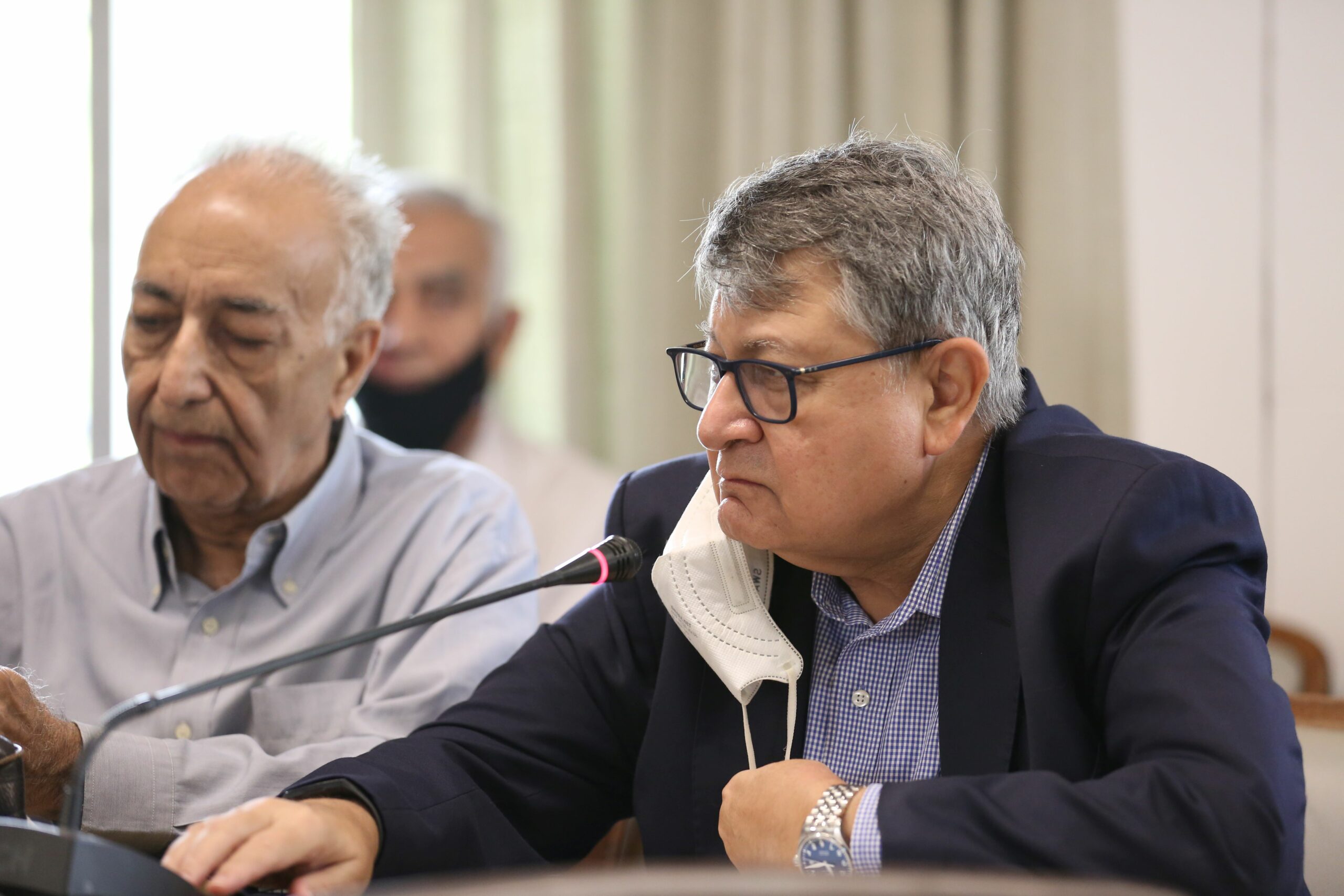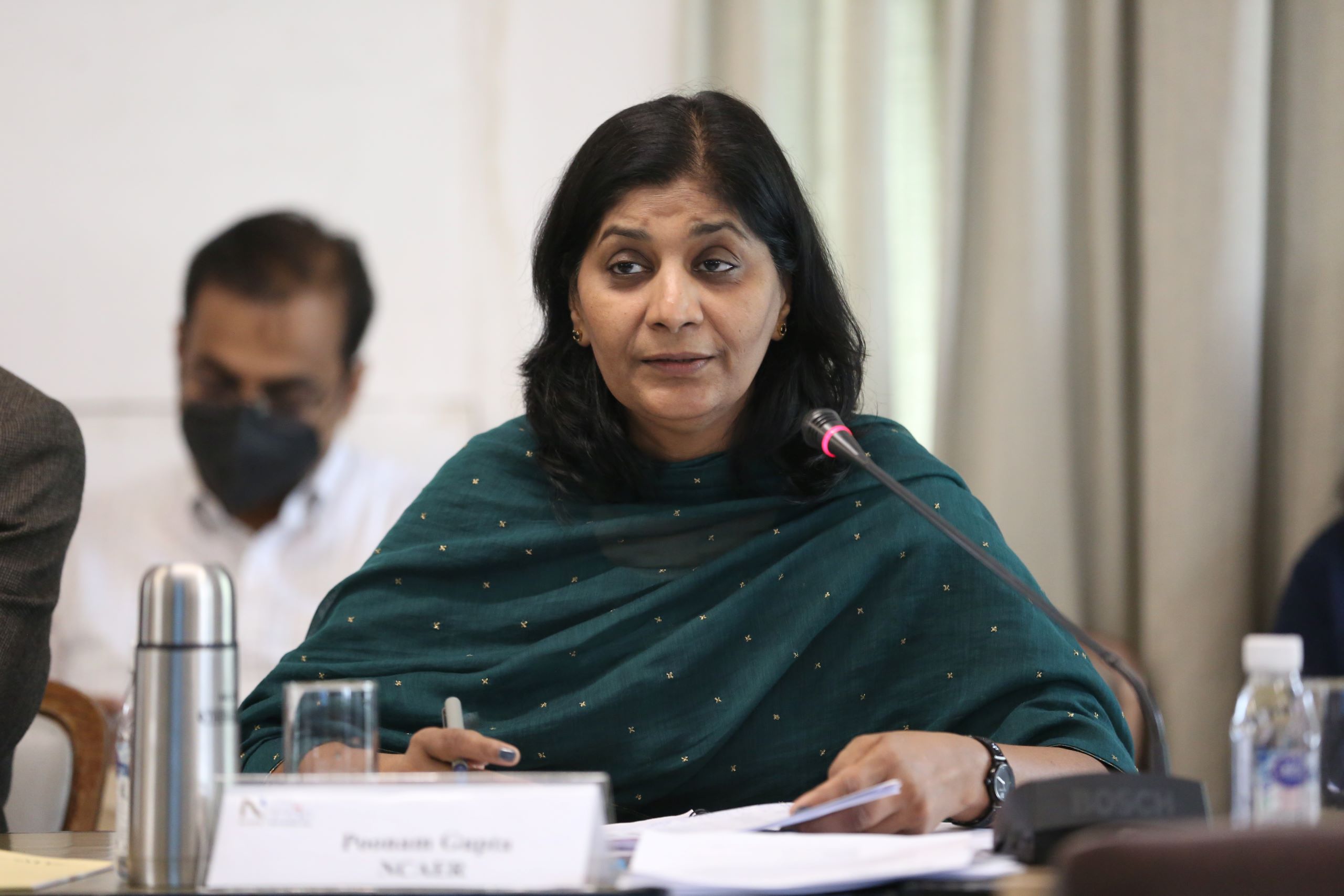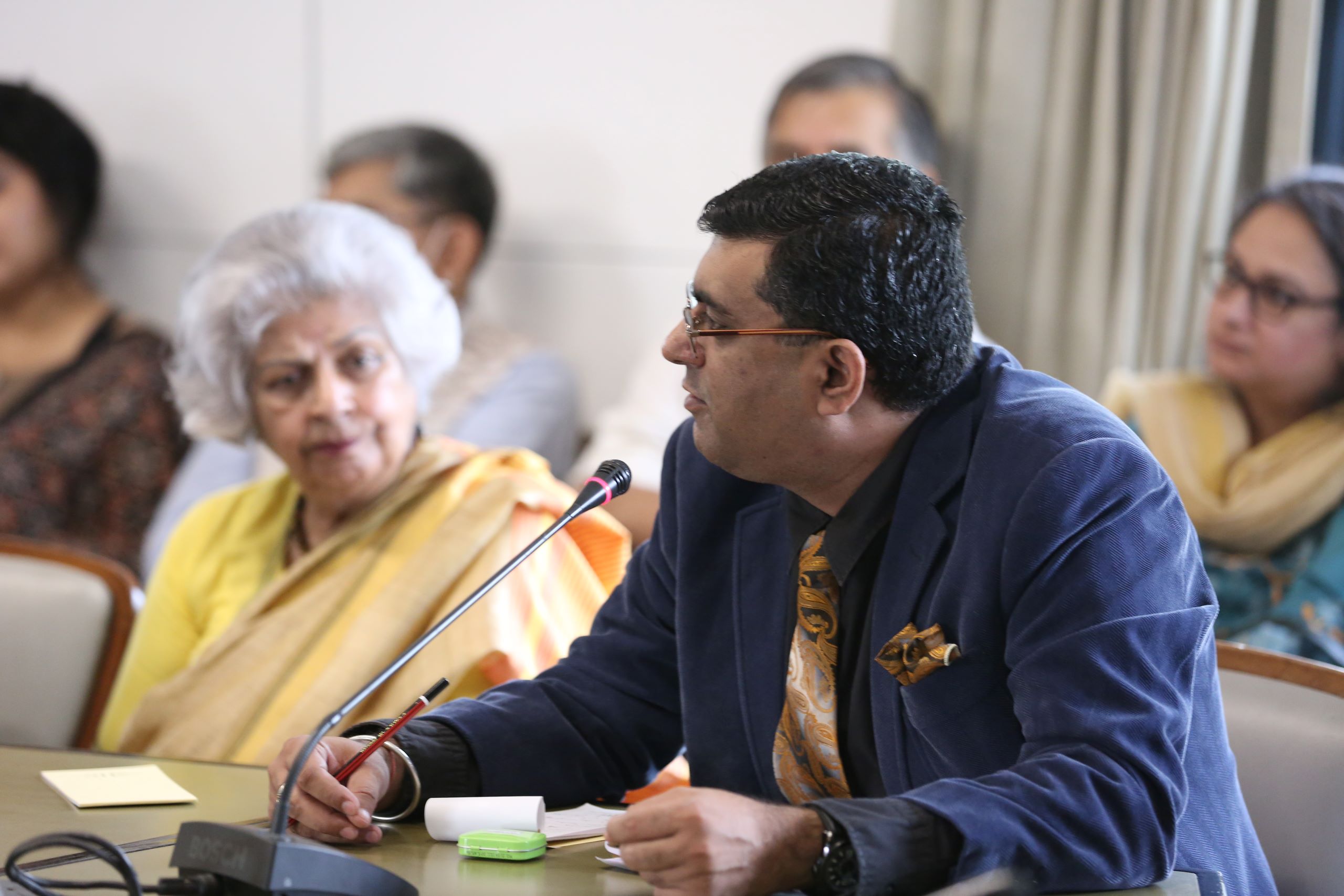The National Council of Applied Economic Research (NCAER) and India International Centre (IIC) organised an insightful, expert commentary, and a lively debate on “The Mid-Year Review of the Indian Economy, 2022-23” on November 5, 2022, at IIC. The NCAER Mid-Year Review (MYR) carries forward the tradition started by Dr Malcolm Adiseshiah at the IIC in 1976 through Malcolm and Elizabeth Adiseshiah Trust.
The NCAER macro team led by NCAER Director General, Dr Poonam Gupta and IEPF Chair Professor, Dr Mridul Saggar, presented an analysis of the current economic situation and developments pertaining to the economy during the financial year 2022-23 so far and likely near term outlook.
Professor Arvind Panagariya, Columbia University and Visiting Distinguished Professor at NCAER, chaired the session. Mr Amitabh Kant, India’s G20 Sherpa and Dr V. Anantha Nageswaran, Chief Economic Adviser to the Government of India, discussed the MYR.
Following are the highlights of NCAER’s Mid-Year Review of the Indian economy for the fiscal year 2022-23:
Global Outlook:
- On the global front, a slowdown is a certainty, and there are concomitant risks of a recession in the Euro Area and the US next year.
- The projected global growth for the next few years till 2026 is pegged at 3.7 per cent while the corresponding figures are 2.4 per cent for the Advanced Economies and 4.5 per cent for the Emerging Markets and Developing Economies.
- The world over, inflation has surged to a 26-year high, catching central banks behind the curve, and their response has been seen in aggressive synchronous monetary policy tightening this year.
Economic Outlook for India:
- NCAER’s economic outlook for India is based on an analysis of key high-frequency indicators. Of these, a majority of the indicators, including tax collection; sales of automobiles and tractors; credit growth; mobility of air and rail traffic; platform-based employment indicators; bond yields; exports of services; and the Purchasing Manager’s Index (PMI), have shown buoyancy.
- On the other hand, two indicators, viz., the exports of goods and non-FDI capital flows have shown a weakening.
- Of some concern is the rise in inflation, especially in the prices of food, particularly vegetables, and the rise in oil prices. Inflation has, in fact, exceeded the upper range of the target for several months and has averaged at 7.2 per cent during the current fiscal year, until September 2022.
- The bank credit scenario offers some scope for optimism. Gross Non-Performing Assets (NPAs) too have declined to 5.3 per cent in 2022-23 from 5.9 per cent in 2021-22.
- The fiscal tracker shows that fiscal outcomes for the year 2022-23 are on track. The Central Government has already collected more than 50 per cent of the budgeted receipts for the year till the end of Q2 of 2022-23, and has incurred less than 50 per cent of the budgeted expenditure for the year during the same period. As a result, it has so far recorded only 38 per cent of the fiscal deficit budgeted for the year. This indicates that the Government is on target to control the fiscal deficit, going forward.
- Overall, the long term fiscal math is, however, sticky. While both tax and non-tax revenue have been growing slowly, the revenue expenditure stands at 24.7 per cent of GDP for the current year. Meanwhile, capital expenditure has been growing but continues to remain small at about 4.6 per cent of GDP in 2022-23.
- Public debt is expected to decline very slowly unless the economy grows at a faster rate. Consequently, the fiscal space will remain constrained.
- There have, however, been a number of positive developments, including the introduction of GST; expansion of the tax base; ensuring better tax compliance and greater transparency; and the shift toward capital expenditure.
- The outlook of the financial markets is also favourable. While bond yields have been anchored, India’s equity markets have outperformed global and emerging markets.
- Developments in the external sector and their implications for India’s economic outlook are particularly important because of the global context which will influence our Balance of Payments position.
- Exports have grown very well in the last 15 months but we have seen some softening of that momentum in the last 2-3 months. This will have some impact as India has not decoupled from the global trade outlook. In fact, only a handful of countries, most notably Vietnam (which has made significant gains in exports), have bucked the global trend in this sphere. Our services exports are resilient to the global slowdown in trade but our merchandise exports have been vulnerable to the slowdown.
- The oil price channel has so far had a major impact on India’s growth figures. While the oil price initially increased to about $100 earlier this year, it eventually settled at about $90-95. The World Bank has projected oil price at $92 next year, and the Indian economy is expected to be resilient to this figure. Significantly, the importance of oil prices for the Indian economy will continue to decline as we improve energy efficiency, which will also make the economy quite robust.
- As regards the capital flows, FDI flows are stable but portfolio flows are volatile, with the outflows from India amounting to about $35 billion in the last one year. India is doing well in attracting FDI, but can do even better.
- India receives capital inflows of about $75 billion a year, as per the last five-year average, which include FDI, portfolio flows, NRI deposits, and external commercial borrowings. There is still a current account deficit of about $30 billion a year.
- This year, capital inflows are expected to be smaller and the current account deficit would be larger, resulting in a net balance of payments gap of about $40-50 billion.
Summary of the MYR Findings:
- In conclusion, it may be summarised that the Indian economy is showing growth and resilience during the year, despite an unprecedented grim global environment.
- However, the Indian economy is routinely subjected to shocks such as global demand shocks, capital flow volatility shocks, oil price shocks, and vegetable price shocks.
- Building resilience to these shocks would thus enable the Indian economy to grow in a more stable fashion.
- Some of this resilience, at least on the capital account side, can be a part of the G-20 agenda.
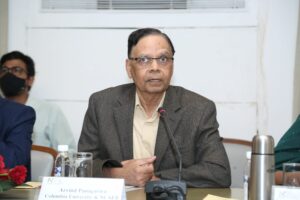 During the discussion, the Chair, Professor Arvind Panagariya noted, “My forecast for growth of the Indian economy for the year 2022-23 would be about 8 per cent. This is because during the first quarter of the year, we have already achieved a growth figure of 13.5 per cent of GDP. In order to achieve a growth of 8 per cent, we need to touch a total of 32 per cent for the four quarters of the year, and having achieved 13.5 per cent in the first quarter, we need to achieve a total of 18.5 per cent in the remaining three quarters, which is absolutely doable. ”
During the discussion, the Chair, Professor Arvind Panagariya noted, “My forecast for growth of the Indian economy for the year 2022-23 would be about 8 per cent. This is because during the first quarter of the year, we have already achieved a growth figure of 13.5 per cent of GDP. In order to achieve a growth of 8 per cent, we need to touch a total of 32 per cent for the four quarters of the year, and having achieved 13.5 per cent in the first quarter, we need to achieve a total of 18.5 per cent in the remaining three quarters, which is absolutely doable. ”
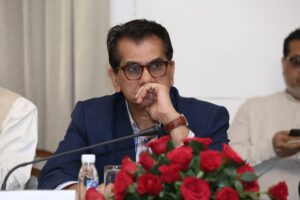 Reflecting on the economic indicators during the year and the concomitant analysis in NCAER’s MYR, Mr Amitabh Kant suggested, “All our high-frequency indicators, as also reflected in the NCAER MYR, are robust and underscore the resilience of the Indian economy. The two important indicators that need attention and a response are rising commodity prices and depreciating currency in the face of the strengthening of the US dollar.” He also said, “We have achieved success in many areas, especially in manufacturing, and now we need to focus on the sunrise sectors and the green transition sectors.” According to him, one of the key measures will be asset monetisation, while the others would be increasing the plugging of private resources into infrastructure, boosting public-private partnerships, and focusing on increasing disinvestment. He also surmised that India could be the first country worldwide that would develop at an unprecedented rate without any carbonisation.
Reflecting on the economic indicators during the year and the concomitant analysis in NCAER’s MYR, Mr Amitabh Kant suggested, “All our high-frequency indicators, as also reflected in the NCAER MYR, are robust and underscore the resilience of the Indian economy. The two important indicators that need attention and a response are rising commodity prices and depreciating currency in the face of the strengthening of the US dollar.” He also said, “We have achieved success in many areas, especially in manufacturing, and now we need to focus on the sunrise sectors and the green transition sectors.” According to him, one of the key measures will be asset monetisation, while the others would be increasing the plugging of private resources into infrastructure, boosting public-private partnerships, and focusing on increasing disinvestment. He also surmised that India could be the first country worldwide that would develop at an unprecedented rate without any carbonisation.
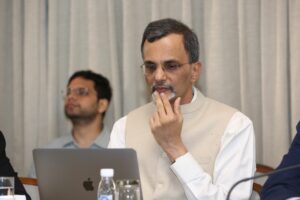 Providing a very comprehensive overview of the economic outlook, the Chief Economic Adviser, Dr Anantha Nageswaran stated, “India’s bond yields are doing much better than those of others, which is indicative of the prevailing macroeconomic stability in India despite the opposite global trends.” He argued that the projections, including both the optimistic and pessimistic ones, should, however, be taken with some degree of scepticism because of the ‘unknown unknowns’”. “Among these ‘unknown unknowns’ are the central banking measures, which could lead to negative interest rates in Europe during the coming decade, stemming both from the Global Financial Crisis of 2007-08, and the impact of the pandemic and the response to it by the advanced economies,” he said.
Providing a very comprehensive overview of the economic outlook, the Chief Economic Adviser, Dr Anantha Nageswaran stated, “India’s bond yields are doing much better than those of others, which is indicative of the prevailing macroeconomic stability in India despite the opposite global trends.” He argued that the projections, including both the optimistic and pessimistic ones, should, however, be taken with some degree of scepticism because of the ‘unknown unknowns’”. “Among these ‘unknown unknowns’ are the central banking measures, which could lead to negative interest rates in Europe during the coming decade, stemming both from the Global Financial Crisis of 2007-08, and the impact of the pandemic and the response to it by the advanced economies,” he said.
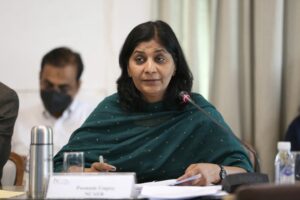 The NCAER Director General, Dr Poonam Gupta pointed out, “The global outlook is both challenging and uncertain, but the available high-frequency indicators that the NCAER Mid-Year Review has taken into account highlight the resilience of the Indian economy.” She also said that the worrying indicators globally were the rise in inflation in all advanced economies, policy tightening by the US Fed and other central banks, and softening of both global growth and global trade, which could impact the Indian economy too.
The NCAER Director General, Dr Poonam Gupta pointed out, “The global outlook is both challenging and uncertain, but the available high-frequency indicators that the NCAER Mid-Year Review has taken into account highlight the resilience of the Indian economy.” She also said that the worrying indicators globally were the rise in inflation in all advanced economies, policy tightening by the US Fed and other central banks, and softening of both global growth and global trade, which could impact the Indian economy too.
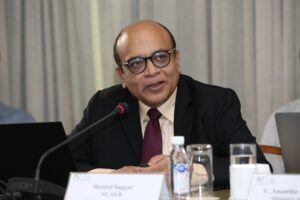 The IEPF Chair Professor, NCAER, Dr Mridul Saggar highlighted the need for maintaining macro-financial stability amid the sharp slowdown in global growth and tighter financial conditions expected next year on the back of further monetary tightening.
The IEPF Chair Professor, NCAER, Dr Mridul Saggar highlighted the need for maintaining macro-financial stability amid the sharp slowdown in global growth and tighter financial conditions expected next year on the back of further monetary tightening.






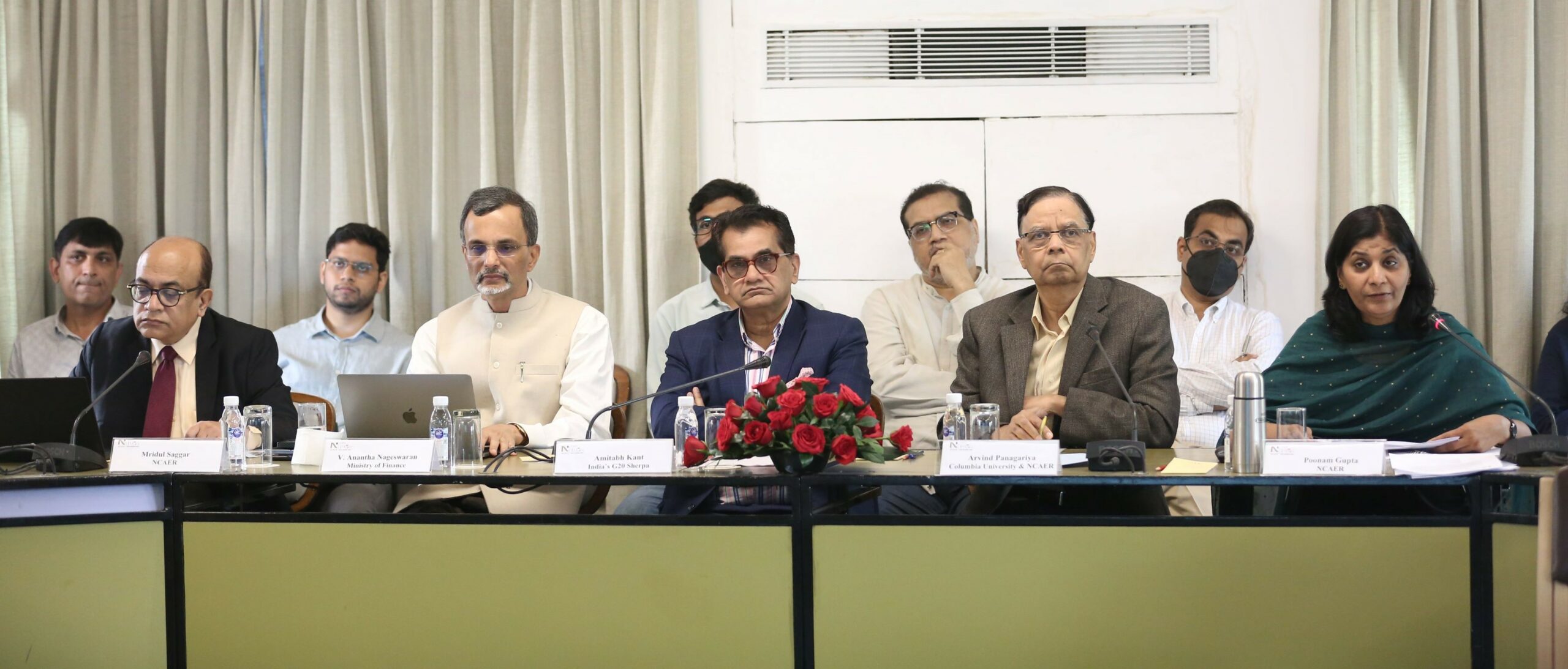
 During the discussion, the Chair, Professor Arvind Panagariya noted, “My forecast for growth of the Indian economy for the year 2022-23 would be about 8 per cent. This is because during the first quarter of the year, we have already achieved a growth figure of 13.5 per cent of GDP. In order to achieve a growth of 8 per cent, we need to touch a total of 32 per cent for the four quarters of the year, and having achieved 13.5 per cent in the first quarter, we need to achieve a total of 18.5 per cent in the remaining three quarters, which is absolutely doable. ”
During the discussion, the Chair, Professor Arvind Panagariya noted, “My forecast for growth of the Indian economy for the year 2022-23 would be about 8 per cent. This is because during the first quarter of the year, we have already achieved a growth figure of 13.5 per cent of GDP. In order to achieve a growth of 8 per cent, we need to touch a total of 32 per cent for the four quarters of the year, and having achieved 13.5 per cent in the first quarter, we need to achieve a total of 18.5 per cent in the remaining three quarters, which is absolutely doable. ” Reflecting on the economic indicators during the year and the concomitant analysis in NCAER’s MYR, Mr Amitabh Kant suggested, “All our high-frequency indicators, as also reflected in the NCAER MYR, are robust and underscore the resilience of the Indian economy. The two important indicators that need attention and a response are rising commodity prices and depreciating currency in the face of the strengthening of the US dollar.” He also said, “We have achieved success in many areas, especially in manufacturing, and now we need to focus on the sunrise sectors and the green transition sectors.” According to him, one of the key measures will be asset monetisation, while the others would be increasing the plugging of private resources into infrastructure, boosting public-private partnerships, and focusing on increasing disinvestment. He also surmised that India could be the first country worldwide that would develop at an unprecedented rate without any carbonisation.
Reflecting on the economic indicators during the year and the concomitant analysis in NCAER’s MYR, Mr Amitabh Kant suggested, “All our high-frequency indicators, as also reflected in the NCAER MYR, are robust and underscore the resilience of the Indian economy. The two important indicators that need attention and a response are rising commodity prices and depreciating currency in the face of the strengthening of the US dollar.” He also said, “We have achieved success in many areas, especially in manufacturing, and now we need to focus on the sunrise sectors and the green transition sectors.” According to him, one of the key measures will be asset monetisation, while the others would be increasing the plugging of private resources into infrastructure, boosting public-private partnerships, and focusing on increasing disinvestment. He also surmised that India could be the first country worldwide that would develop at an unprecedented rate without any carbonisation. Providing a very comprehensive overview of the economic outlook, the Chief Economic Adviser, Dr Anantha Nageswaran stated, “India’s bond yields are doing much better than those of others, which is indicative of the prevailing macroeconomic stability in India despite the opposite global trends.” He argued that the projections, including both the optimistic and pessimistic ones, should, however, be taken with some degree of scepticism because of the ‘unknown unknowns’”. “Among these ‘unknown unknowns’ are the central banking measures, which could lead to negative interest rates in Europe during the coming decade, stemming both from the Global Financial Crisis of 2007-08, and the impact of the pandemic and the response to it by the advanced economies,” he said.
Providing a very comprehensive overview of the economic outlook, the Chief Economic Adviser, Dr Anantha Nageswaran stated, “India’s bond yields are doing much better than those of others, which is indicative of the prevailing macroeconomic stability in India despite the opposite global trends.” He argued that the projections, including both the optimistic and pessimistic ones, should, however, be taken with some degree of scepticism because of the ‘unknown unknowns’”. “Among these ‘unknown unknowns’ are the central banking measures, which could lead to negative interest rates in Europe during the coming decade, stemming both from the Global Financial Crisis of 2007-08, and the impact of the pandemic and the response to it by the advanced economies,” he said.  The NCAER Director General, Dr Poonam Gupta pointed out, “The global outlook is both challenging and uncertain, but the available high-frequency indicators that the NCAER Mid-Year Review has taken into account highlight the resilience of the Indian economy.” She also said that the worrying indicators globally were the rise in inflation in all advanced economies, policy tightening by the US Fed and other central banks, and softening of both global growth and global trade, which could impact the Indian economy too.
The NCAER Director General, Dr Poonam Gupta pointed out, “The global outlook is both challenging and uncertain, but the available high-frequency indicators that the NCAER Mid-Year Review has taken into account highlight the resilience of the Indian economy.” She also said that the worrying indicators globally were the rise in inflation in all advanced economies, policy tightening by the US Fed and other central banks, and softening of both global growth and global trade, which could impact the Indian economy too. The IEPF Chair Professor, NCAER, Dr Mridul Saggar highlighted the need for maintaining macro-financial stability amid the sharp slowdown in global growth and tighter financial conditions expected next year on the back of further monetary tightening.
The IEPF Chair Professor, NCAER, Dr Mridul Saggar highlighted the need for maintaining macro-financial stability amid the sharp slowdown in global growth and tighter financial conditions expected next year on the back of further monetary tightening.



